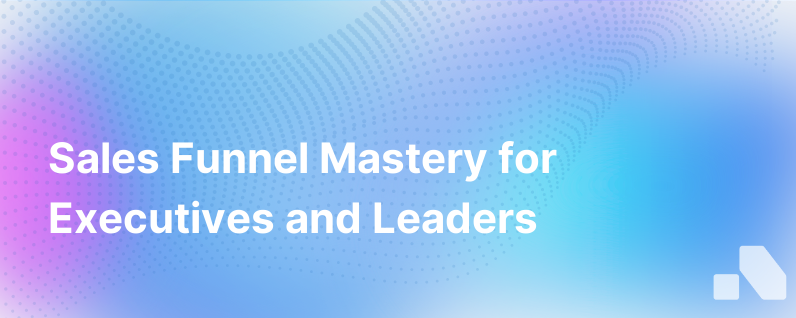
In the dynamic ecosystem of B2B sales, the blueprint for turning prospects into loyal customers is often envisioned as a funnel – a sales funnel. The sales funnel represents the journey that potential customers go through on their way to purchase. This journey is not a straight path but rather a complex and sometimes circuitous route that necessitates a nuanced understanding of human behavior, market dynamics, and the subtle art of persuasion.
Understanding and optimizing your sales funnel is paramount in carving out a successful niche in the competitive B2B landscape. In this article, we'll journey through the intricacies of the sales funnel, providing a guide on crafting and utilizing it to its maximum potential.
The Concept of the B2B Sales Funnel
At its core, the sales funnel is a metaphor that encapsulates the stages from initial contact to final sale. It's called a funnel because at the start, you reach out to a broad audience of potential customers (the wide top of the funnel), and as they move through the funnel's stages, the audience narrows down through various processes – akin to qualifying – until only those who are most likely to purchase remain.
Let's break down the common stages of the sales funnel that typically consist of:
Awareness: The potential customer becomes aware of their problem and your solution. This stage is all about catching the eye of your prospects. It’s where content marketing, social media campaigns, and other outreach activities come into play.
Interest: Once aware, the prospects express an interest in your products or services. This stage is about sparking curiosity and engaging these potential buyers, often by providing more information and education about how you can solve their problems.
Consideration: At this stage, the potential customer starts considering your offer more seriously, weighing it against competitors. Demonstrations, tailored proposals, and free trials often become critical during this phase.
Intent: Intent indicates a strong possibility that the customer wants to purchase your service or product. It often involves a request for a quote or a more in-depth conversation about the offering.
Evaluation: The customer meticulously evaluates the proposed solution, ironing out details and terms before making the final commitment. It’s where sales teams must address any remaining concerns and push for a close.
Purchase: Congratulations! The prospect has been converted into a customer. But the journey doesn't end here; retaining the customer and potentially upselling in the future are crucial next steps.
Key Considerations in Building a Sales Funnel
Crafting an effective sales funnel is no menial task. It requires an iterative approach, underpinned by data analysis and customer feedback.
Understand Your Audience
Create detailed buyer personas. These are fictional representations of your ideal customers based on real data about customer demographics and behavior, along with educated speculation about their personal histories, motivations, and concerns.
Capture Leads at the Top
Adopt inbound marketing strategies to attract potential customers. High-value content such as ebooks, whitepapers, and webinars can be leveraged to engage leads. Ensure that your SEO strategies align with the content you're creating to capture traffic and leads efficiently.
Nurture Through the Funnel
Develop email drip campaigns that are triggered by certain actions taken by the leads. This nurturing process keeps your brand on the potential customer's radar, gently guiding them towards the consideration stage with valuable information and persuasive content.
Leverage Social Proof
Case studies, testimonials, and reviews can greatly enhance credibility and trust, coaxing leads down the funnel. Nothing speaks louder than a success story from a peer in the industry.
Make the Conversion Process as Smooth as Possible
This might involve optimizing the checkout process on the website, providing various payment options, or guaranteeing support post-purchase. Think convenience and reassurance.
Test and Optimize
Use A/B testing to see what resonates with your audience and what doesn't. Iteratively refine your funnel based on observed behaviors and conversion rates.
Retain and Grow
Focus on customer success to not only retain them but also identify opportunities for upselling, cross-selling, and turning them into champions of your brand.
Closing the Deal and Beyond
Closing a deal is an art in itself, and the subtleties of negotiating and personalizing offers can make all the difference. However, even after the final handshake, the sales funnel still holds value—a satisfied customer can loop back into the funnel as a valuable referral source or a repeat buyer.
Implementing a CRM system helps in tracking leads' progress through the sales funnel stages, providing vital metrics that can be analyzed to improve performance steadily. Every interaction and negotiation is a piece of data that informs the overall strategy and fine-tunes the effectiveness of your sales funnel.
Conclusion
An effective sales funnel is essential in understanding how to attract, engage, and convert prospects into customers. It's about creating and nurturing relationships, understanding customer needs, and providing value every step of the way.
B2B sales require a particularly well-thought-out and meticulously implemented funnel strategy due to the nature of high-value, high-commitment decisions made by business consumers. Remember, your sales funnel is not a static structure; it's a dynamic, evolving process that should continually adapt to the rhythms of your market and the behaviors of your customers.
Optimizing your sales funnel can lead to increased conversions, stronger customer relationships, and sustainable revenue for your business. It's a strategic investment that, when executed properly, pays manifold dividends over time.